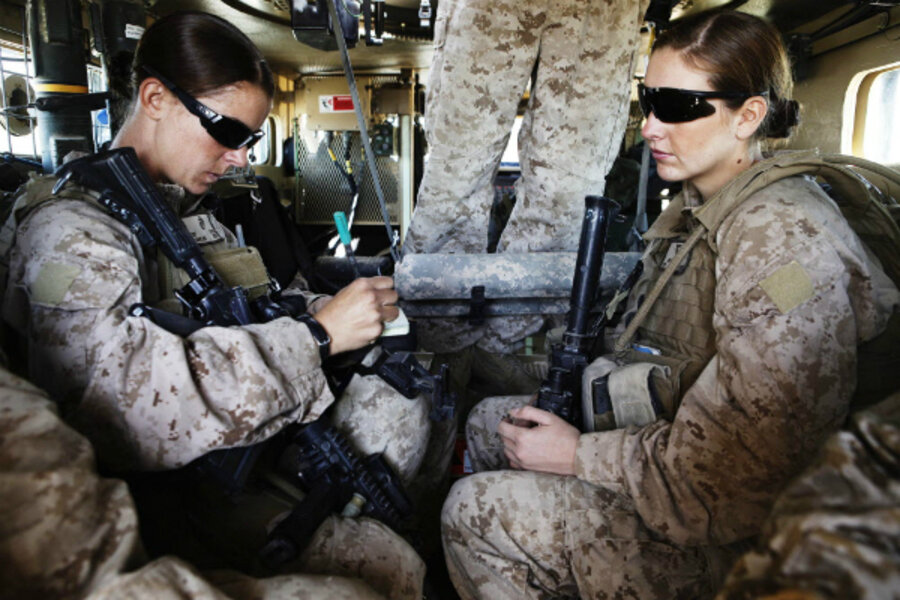Women allowed in combat: Will that mean it's less safe for men?
Loading...
| WASHINGTON
With women now allowed to serve on the front lines, are men going to be more in danger on the battlefield?
And will America’s national security be jeopardized by men leaving the infantry in droves because they no longer see it as a tough, elite calling?
These have long been frequently-cited reasons for not allowing women to serve in combat.
“I think some men will leave the infantry,” says one senior Marine Corps officer. “You’ve got to ask yourself why most young men join the Marine Corps, especially that group that wants to be infantrymen.”
The answer, in many cases, is to “shoot stuff and blow things up,” he adds. “So some percentage of those guys would be like, it wouldn’t be as much fun.”
These arguments are often closely linked to the shared physical hardships that lead to espirit de corps.
Can a woman carry her fellow soldiers out of danger, or hike long distances lugging heavy packs without falling behind and holding her fellow soldiers back?
“The answer to that is very straightforward: Create a physical fitness standard,” says Anne Coughlin, a professor at the University of Virginia School of Law, in Charlottesville, Vir., who is spearheading a conference Feb. 1 on women in combat in Washington, D.C.
“That’s all the litigation would ask for, or – to be candid – all that we would want.”
Yet some worry that as women fail to meet physical fitness standards, the Pentagon will be tempted to lower them.
Recent history suggests that some standards are getting higher. The Marine Corps just got rid of the flexed arm hang for women as a physical fitness standard, and instead implemented pull-ups. Women must complete two pull-ups to pass the physical training (PT) test, and eight to max it out. Men receive the highest scores for 18 pull-ups, and must complete two to pass.
“My great fear is that once they’re open, and there are physical tests and so forth – you have to be able to bench press this, carry this, hump a 70 lb. rucksack or whatever it is – then the advocates for women in combat will say, ‘Those standards aren’t appropriate,’ and they’ll attack the standards,” says Peter Mansoor, professor of military history at the Ohio State University and a former executive officer to Gen. David Petraeus in Iraq.
“My great fear is not that we open up combat arms positions to women, because I think we should,” he says.”My great fear is that we’ll dumb down the standards because women can’t meet them.”
There’s another possible scenario, and that is that the military will attract more talented female athletes who didn’t want to join the military previously because they didn’t want to be limited by lower standards, says Anu Bhagwati, executive director of the Service Women’s Action Network.
A former company commander in the Marine Corps, Ms. Bhagwati was the second woman to complete the Corp’s Martial Arts Program instructor trainer school, earning a black belt in close combat techniques.
“Right now there’s no incentive for women to join the military, because they’re not going to be treated equally,” she says.
While defense officials “think they’re getting the best, many serious women athletes don’t see the military as a possibility because they know they’re not treated equally.”
That unequal treatment is often rooted in closely held cultural beliefs about femininity and fear of misplaced chivalry on the battlefield.
“If a male soldier is protecting other males he gets the medal of honor, but if he does it for females it somehow becomes an act of crazed chivalry that places national security in danger,” says Professor Coughlin.
It’s a line of thinking that tends to be dismissed even by those who have concerns about women in combat.
“Out of all the arguments, that’s the one to me that holds the least water,” says the Marine Corps officer. “Most guys don’t even open the doors for women anymore.”
What’s more, women have been serving alongside men in battle for years. “Everyone’s on the same team – those instances are extremely binary. It’s you and it’s the enemy,” he adds, “and we’re going to win.”
With the right to take part in combat on behalf of their nation comes risks, but also full citizenship, says Bhagwati. “I think in the history of the United States, every marginalized population only gained respect and real citizenship – not just in the sense of the vote, but of one’s peers – through military service,” she adds. “Otherwise you’re not considered 100 percent American. You’re just not.”







